Coastal Wireless Stations - Sydney.
- Home, index, site details
- Australia 1901-1988
- New South Wales
- Overview of NSW
- Telegraph lines
- Telegraph Offices
- Date stamps
- Forms
- Envelopes
- Rates
- Stamps
- Queensland
- Overview of Qld
- Telegraph lines
- Telegraph offices
- Date stamps
- Forms
- Envelopes
- Rates
- Stamps
- South Australia
- Overview of SA
- Telegraph lines
- Telegraph Offices
- Date stamps
- Forms
- Envelopes
- Rates
- Stamps
- Tasmania
- Overview of Tasmania
- General developments
- Reports
- Organisation
- Telegraph lines
- Telegraph Offices
- Date stamps
- Railway lines
- Forms
- Envelopes
- Rates
- Stamps
- Overview of Tasmania
- Victoria
- Overview of Vic.
- Telegraph lines
- Telegraph offices
- Date stamps
- Forms
- Envelopes
- Rates
- Stamps
- Ephemera
- Western Australia
- Overview of WA
- Telegraph lines
- Telegraph Offices
- Date stamps
- Forms
- Envelopes
- Rates
- Stamps
Sydney had six Coastal Radio stations from 1909 to the 1970s. These were:
| Station: | 1 | 2 | 3 | 4 | 5 | 6 |
| Location: | Bulletin office | Australia Hotel | Pennant Hills | Willoughby | La Perouse | Doonside & Bringelly |
Sydney station # 1: Bulletin Office.
The first wireless station to be opened in Australia for the Australasian Wireless Company was an experimental one in Sydney.
It was located at the back of the Bulletin (magazine) offices.
Sydney station # 2: Australia Hotel.
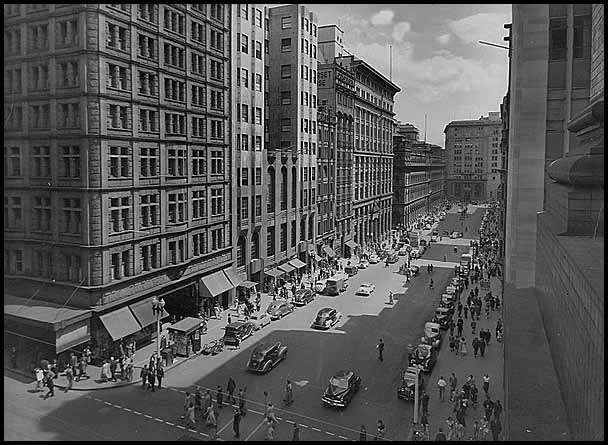 Martin Place with Castlereagh Street in the foreground and the Sydney G.P.O. on the far left side of Martin Place. Notice no clock tower on the G.P.O. The Australia Hotel is the building with the lowered front and the columns of windows on either side (4-5 parked cars on the left of Martin Place).
See also Sydney CBD Telegraph Offices. |
The Hotel hosted many famous events. In 1910 Australasian Wireless Limited obtained a licence from the Postmaster-General's Department to run telegraphy tests, from the hotel's 6th floor, with ships at sea, on 27 August. It was subsequently permitted to handle commercial traffic in 1911 – the first in Australia. Soon after , the station was moved to the top floor of the Australia Hotel in Sydney with the mast attached to the Hotel's chimney. That station was Australia's first coastal radio station handling public traffic to and from ships at sea. The station had a German Telefunken set and remarkable distances for the wireless messages were obtained. The call sign was "AAA". It was however still an experimental station and was used to develop the technology and procedures further. |
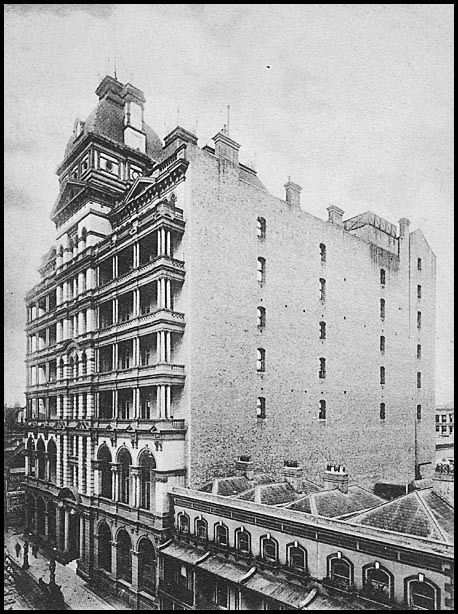 |
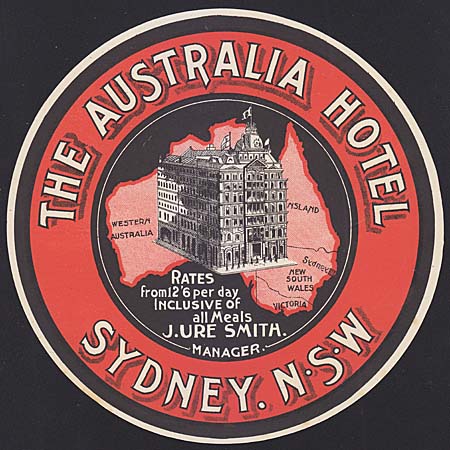 (left): view of the Australia Hotel from King Street. (above): a luggage label provided to the Hotel's guests. |
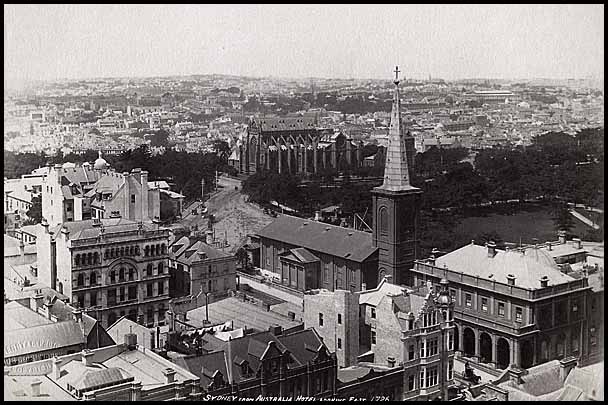 View from the Australia Hotel to the east with St. James Church in the foreground and St Mary's on the other side of a very leafy Hyde Park. Taken about 1926. |
On 20 February, 1912, the Hotel Australia wireless operator stated that "Macquarie Island station's signals were splendid (across 1,800 miles). Macquarie Island has, he says, heard Hotel Australia station for some time past. Macquarie Island messages on 14th February came through as clearly as if only a thousand miles off".
At the end of May 1912, a notice of cancellation of the Hotel Australia wireless station licence was given to the Australasian Wireless Co. The licence for Pennant Hills was issued soon after - although that station was really operated by the Government with technical assistance from Amalgamated Wireless. |
Sydney station # 3: Pennant Hills.
 |
The Australia Hotel station was closed in 1912 when a new station was opened - on 19 August 1912 - at a more suitable locality. It was about 20 km north-west of Sydney's CBD. This location had been announced in August 1910.
Its main tasks were:
In 1925, the Pennant Hills station conducted the first trials in Australia of long-distance ship-to-shore radio telegraphy. It exchanged communications with the SS Niagara, which had been specially fitted out with appropriate equipment, as she sailed between Australia and Vancouver, Canada. The receiving facilities were moved to Willoughby in 1926 which allowed the installation of high frequency equipment at Pennant Hills in 1928 to enable communication with Rabaul (PNG) and Suva (Fiji). By 1928, communication with Port Moresby was opened. The Australian Broadcasting Commission (ABC) Radio Station 2FC also used the Pennant Hills towers for transmission. |
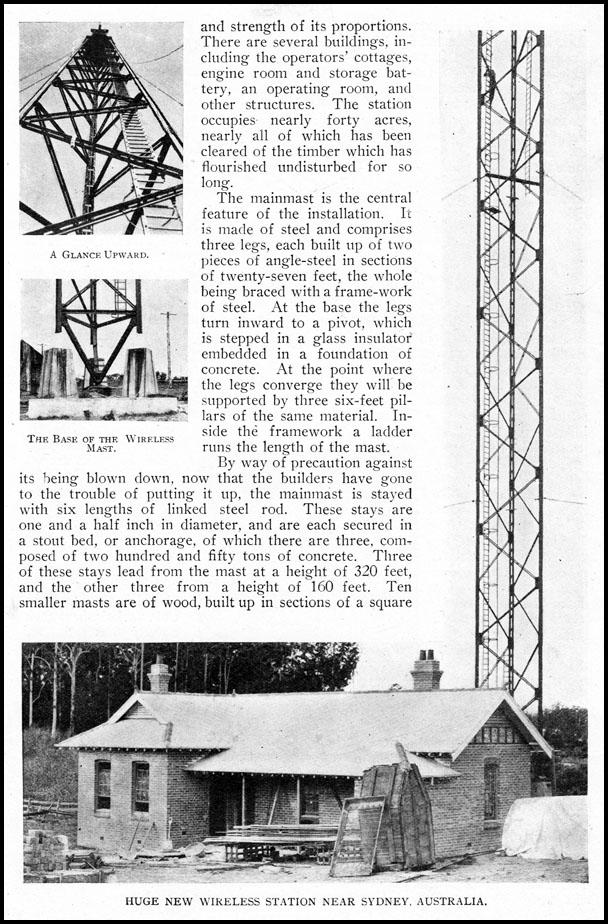 |

Operations were moved to La Perouse on 8 February 1927. |
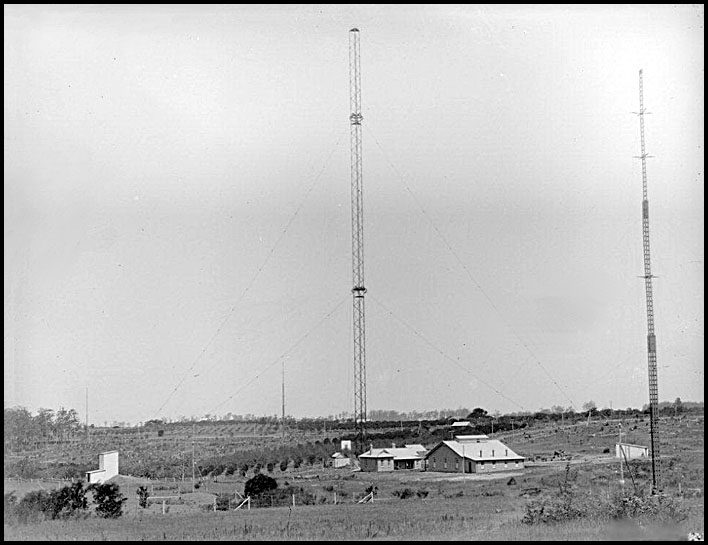 |
The increased demand from ships and increased services available became too much for the Pennant Hills station to implement in addition to the heavy transmission load. Hence, in 1926, the receiving facilities were moved to Willoughby (on Sydney's lower north shore).
| The Eastern Extension Company completed the construction of the Cable Station building at Laperouse. That enabled the temporary wooden huts to be replaced. The building was designed by the Colonial Architect James Barnett. The building shown here was completed in 1882.
This station was located in the heights of La Perouse overlooking Botany Bay. It was officially opened about 10 February and commenced operations on 28 February 1927. It became the permanent Costal Radio Service receiving station in Sydney. Its call sign was VIS. Details of the station and its linkages to other stations can be found elsewhere. La Perouse had previously been the station from where the first cable to New Zealand had been laid. |
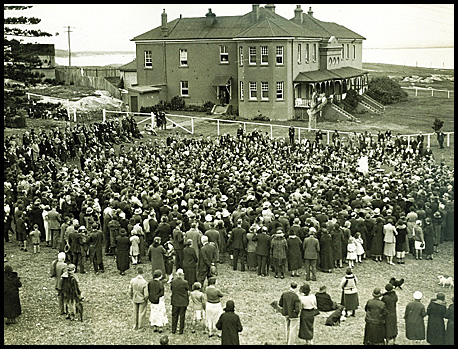 Picture taken in 1933 when a new grave was established for Father Receveur. The Eastern Extension buildings are in the background with Botany Bay behind. |
The enormous ranges by short-wave working were demonstrated by the reception at La Perouse of experimental communications from short-wave stations in Great Britain and Europe, the United States and Canada, Africa, Asia and the Dutch East Indies. When functions were moved to the western suburbs in 1955/56, La Perouse continued to be the most important station in Australia's Coastal Radio service. The list of projects in which the La Perouse station was involved is impressive ranging from Kingsford Smith's San Francisco to Australia flight and his Australia to London flight, Commander Byrd's Antarctic Expedition and two-way communication with the German steamer Bremen when she was establishing a record run across the Atlantic in addition to the coatal shipping and communication with PNG and Fiji.
Sydney Station 6: Doonside and Bringelly.
The change in responsibility for telegraphic services to the Overseas Telecommuncations Centre (OTC) on 1 February 1947 brought another change in the Sydney stations. Two new sites in Sydney's western suburbs were purchased in 1950. In 1955-56, the transmitting facilities were relocated to Doonside and remotely operated from La Perouse. The receiving facilities were relocated to Bringelly.
When the Coastal Radio Services were re-organised in the 1990s, the facilities at Doonside and Bringelly were moved to Brisbane.